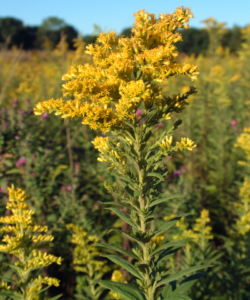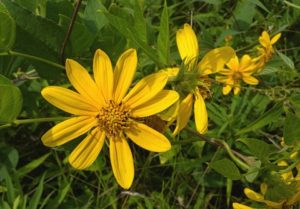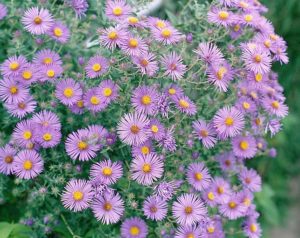As I think about it, the land seems to first wake up in springtime in the forest, starting with the wildflowers that erupt from the ground in shades of white, lavender, pink, and yellow. Their life and color seem to flow outward as spring and summer progress to the meadows and roadsides which slowly green up then bloom with even greater intensity. The hot days of summer can be hard on them, but these cooler times with moist mornings seem to urge plants to flower with enthusiasm before the cold sets in.

goldenrod
Three groups are particularly showy this time of year: sunflowers, goldenrods, and asters. All of them produce many hundreds or thousands of flowers on a single plant, sometimes grouping many into what appears to be a single bloom. There are hundreds of species of these plants and they are noticeable by intent. They are also vitally important to many animals.
All of them belong to the order of plants called Asterales, within which there are nearly a dozen families of plants. It is fascinating to follow how scientists are trying to determine how living things evolved based on common genetic traits. In this case, it’s interesting to note that the flowers of the Asterales seem to have a common ancestor which was a woody tree or shrub, even though few of the existing members of the order are as such now.
The familiar goldenrods here belong to the genus Solidago and include the aggressive Canada goldenrod of fields, the grass-leaved goldenrod, and stiff goldenrod, a favorite for wildflower restoration projects. All are native plants, and if you look closely you will find many bees, wasps, and soldier beetles seeking pollen on the flower heads. You may also notice bumps (galls) on the stems where fly or moth larvae have made a home. Sometimes a lovely goldenrod crab spider waiting to ambush prey, or a large black and yellow garden spider in an orb web between stems can be seen.
The sunflowers, yellow and familiar, sometimes interbreed and can be hard to tell apart. They are smaller cousins to the giant domestic sunflowers we have engineered for cultivation. The woodland sunflower, downy sunflower, and tall sunflower are a few of the many species that are blooming now, along with a number of related coneflowers and others. They too, are very attractive to bees and butterflies. Goldfinches are often present to feed on the insects, and later the sunflower seeds when they first ripen.

sunflower
The white, blue, and purple asters recently appearing add variety to all the yellow in the native landscape created by the goldenrods and sunflowers. In sunflowers and asters, what appears to be a single flower is actually many small flowers arranged in a disc-shaped spiral, surrounded by sepals which look like they should be petals. New England asters produce the lovely purple bouquets we see now in meadows. Sky blue asters and smooth asters are instead a light blue color, and there are many species of little white asters which can be hard to identify. One, the panicled aster, fills some of the swales at Woodland Dunes with tiny which blooms that can be covered with bumblebees and other beneficial insects. One hardly notices the plants until they suddenly bloom in September, but when they do, the insects are waiting to feed on some of the last pollen and nectar of the growing season.

aster
These common wildflowers fuel the last activities of insects in the fall- insects which feed the migrating birds and dragonflies struggling to reach their winter homes. At the same time they color the world around us, something that for some reason people seem to appreciate. Perhaps we unconsciously realize the importance of their blooming to the natural world and our well-being.
photos-Canada goldenrod, woodland sunflower, New England aster
